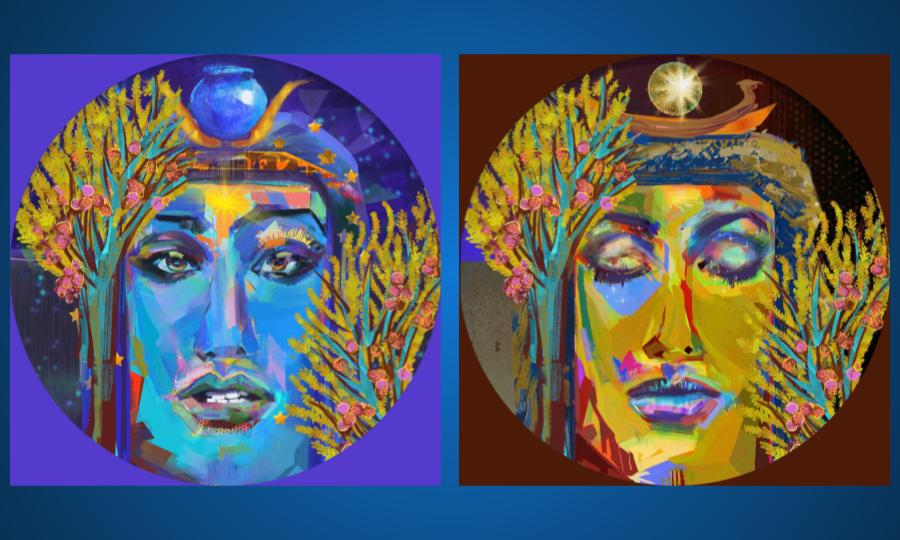Egyptian Goddess Nut: A Recurrent Figure in the Work of Nancy Spero / Her Digital Avatars by Anaïs Zhang.
“Only a machine can appreciate a sonnet written by another machine.” – R. Queneau
A comparison of the work of two artists on the same mythological figure will allow us to analyze some aspects of the concept of series in art.
Nut in Nancy Spero’s Work: The Matrix and the Cannibal
Biography
Nancy Spero (1926-2009) spent her life trying to “find her voice” as an artist and as a woman. She studied at the Art Institute of Chicago, where she met and married artist Leon Golub. They spent time in Italy and then in Paris (1958-1964). Upon their return to New York, she was deeply shocked by the Vietnam War. However, her War series barely attracted any notice. Abstract art dominated the scene with major figures like Jackson Pollock and Mark Rothko. Her figurative art conveyed a strong political message, which stood in contrast to an art movement celebrating painting for its own sake, liberated from aesthetic, moral, and political considerations. Undeterred, Spero pursued her work as an artist and activist. Feminism became an essential battle for her. In 1972, she joined the A.I.R gallery, the first American cooperative gallery dedicated to women. These political engagements influenced her artistic techniques. She renounced oil painting on canvas early on, seeing it as too closely linked to male domination in the arts. Her great originality lay in creating works out of collages and hand-printing. The female body and female experience became the central themes of her art.
Rewriting History: The Female Experience
Spero’s brutal images depict the atrocities of the Holocaust, the Vietnam War, and the dictatorship of Pinochet. However, the artist emphasizes the impact of these events on women, illustrating how they become victims in both body and soul. She incorporates real documents into her work: newspaper articles, photographs, reports from Amnesty International, and case histories of torture, often mentioning the victims’ names. There is a need to provoke, to anger, to compel the viewer to take action on an individual or collective level against these recurring abominations; as Spero put it, it’s always “the same damn thing.” According to the artist, women have been erased from history; they have been there but written out. There is an absolute necessity to recast them as protagonists of history. This led Spero to collect photographs of female figures represented in art from all time periods and cultures, including prehistory, ancient Egypt, Sumer, Ancient Greece, and Australian Aboriginal cultures. She then had the idea of transferring these photographs onto plates of zinc, amassing a stock of around 900 images over the years. Each plate serves as a matrix that can be used repeatedly. Her work consists of hand-prints and collages of mythical and historical figures culled from various sources, as well as contemporary images of women. The aim of these striking juxtapositions is to reveal that women have been victims of a male-dominated history, but they can also be models of empowerment. In one of her hand-prints from 1992, we see five women: the Roman goddess Diana, a contemporary dancing figure with stars on her chest, a prehistoric idol, an Aboriginal figure, and a female bodybuilder. The words “we are pro-choice” are scribbled above them, referring to the title of a poster defending women’s right to abortion. The print proves that across different time periods and cultures, women exemplify positions of strength and independence. We shall provide further examples of these collages when discussing the goddess Nut. The complex dialogue between ancient and modern figures gives a universal dimension to women’s struggles and demonstrates their irrepressible presence.
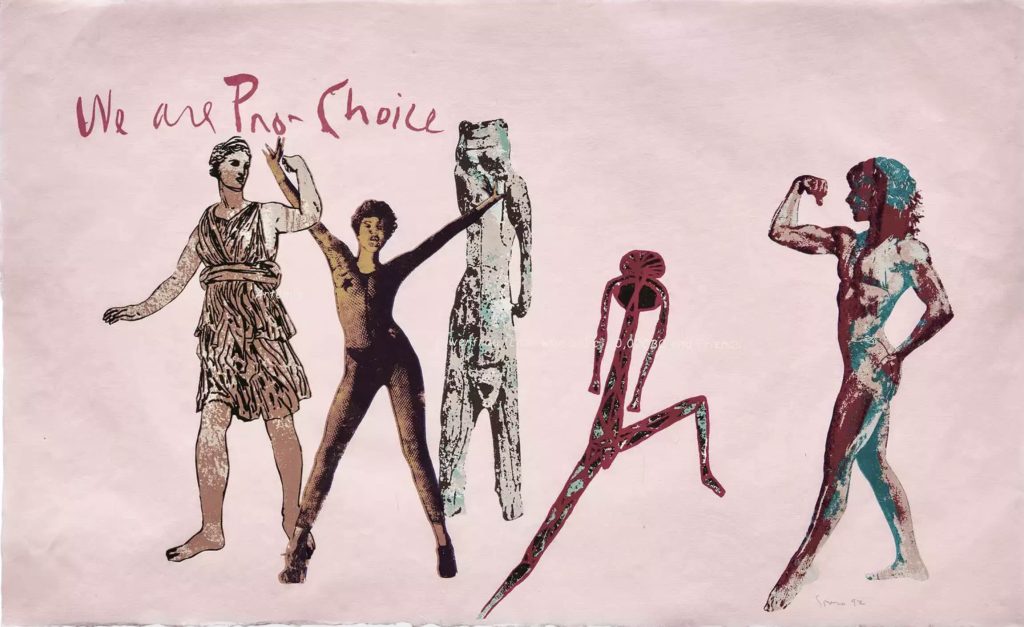
A Recurrent Figure in Her Work: Egyptian Goddess Nut
In Egyptian art, the sky goddess is often depicted as a woman on all fours, stretched over the Earth. Her naked body is sometimes painted blue and covered with stars. She has a slender body, dark hair, a face seen in profile, and jewelry. We can easily understand Spero’s fascination with this goddess. She was a passionate woman, madly in love with the Earth god Geb. However, she was forbidden to have intercourse with him because it would disrupt the structure of the universe, causing the sky and earth to collapse. That is why in pictures, her father Shu holds her firmly to separate her from Geb. Nevertheless, Nut disobeyed the rules and, through cunning devices, produced a countless number of children. Thus, she exemplifies a powerful female figure, aware of her sexuality and unhesitant to defy male authority. Spero retains the slender, arched figure seen in profile, but she liberates the goddess from her cosmic duties: no more Geb or Shu. In the prints, the artist varies the position of the body and the skin color. Here are three prints in which Nut appears: [Include link to images]. This print features Nut shown sideways with Diana, the Roman goddess. They may seem very different—Diana being a virgin by choice and Nut a passionate lover and fertile mother. However, both goddesses have, in their own ways, defied dominant male rule. Nut and Acrobat is a hand-print on handmade paper dating from 1989. There is a striking resemblance between the two slender figures, the ancient goddess and the modern acrobat. Both leap, freed from gravity and gravitas. They dance in the air. Dance is a recurring theme in Spero’s art. She read in a book on prehistoric art that dance was the first language of humanity. Dances can be part of sacred rituals, but they are also jubilatory celebrations of the body. Goddess Nut and Torture Victim is a hand-printed linocut in colors with collage dating from 1991. This is a darker piece. The victim is laid on a stretcher, frail and tormented. She exemplifies all that women have to endure. But Nut (pictured twice) is stretched over her and seems to protect her. Once more, the juxtaposition of the two images, ancient and contemporary, reminds us that women have been oppressed but they are resilient. Nut is a role model. History can be changed if only we have the courage to take action. [Include link to images]. With humor, Spero talks about “cannibalizing.” Her work seems to feed on itself by endlessly incorporating the same elements. This aspect of series and repetitions evokes Andy Warhol’s serigraphs, but a comparison of the two reveals their different approaches to art.
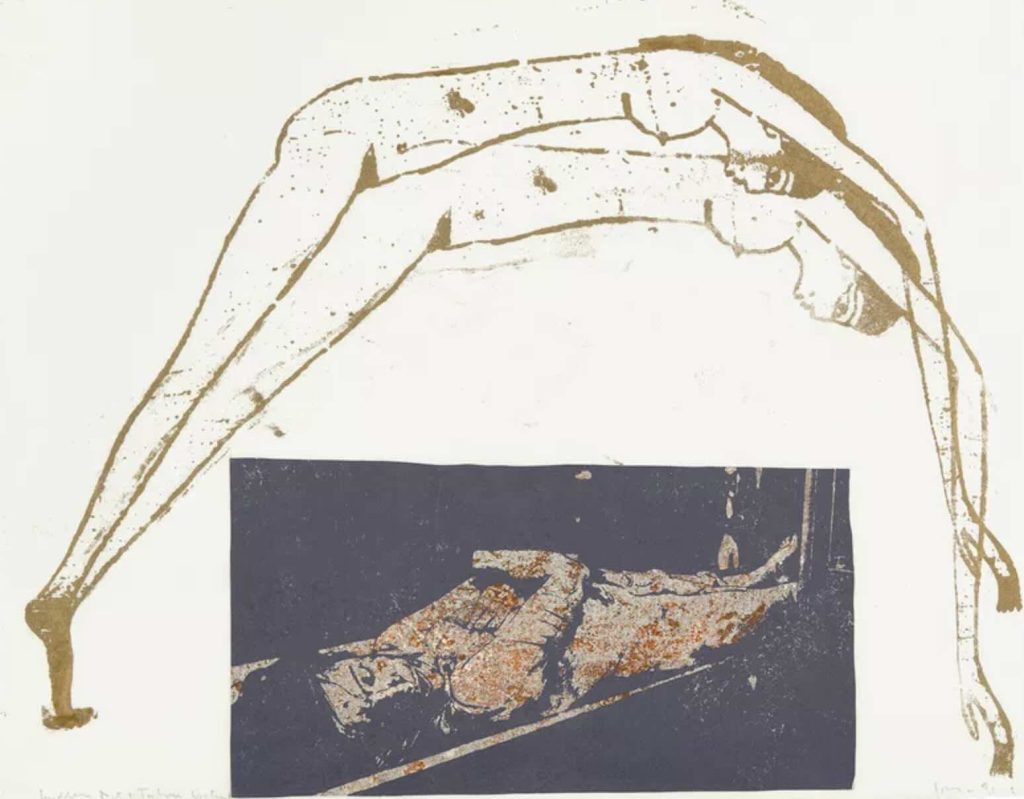

Spero’s Prints and Andy Warhol’s Serigraphs
The printing techniques allow the artist to produce an infinite number of copies from one matrix. This challenges the notion that each piece of art is unique and matchless. Both artists use materials not traditionally associated with “high art.” From an early stage, Spero discarded oil painting for gouache to highlight her pictures. Warhol chose acrylic and even paint bombs used in the automobile industry. Both recycle or repurpose existing materials, undermining the idea that art must be original, expressing the soul of the artist. Both artists use pictures culled from various sources: photographs of ancient works of art, as well as images from magazines and advertisements. However, Warhol does not establish a hierarchy. Following in Marcel Duchamp’s footsteps, anything can become art: the Mona Lisa, a can of soup, a Hollywood starlet. Spero establishes a distinction, and the dialogue between ancient and modern pictures is deliberate and meaningful. Warhol often stated that art is merchandise that could be mass-produced to increase profits. He once said his dream was to produce 4000 pieces a day, advocating for uniformity in size and color. Spero’s work, on the other hand, possesses an artisanal quality. She doesn’t use a press; she hand-presses her collages. Each work is unique, depending on the pressure of the hand and the angle of the plate on the paper. She is very particular about the choice of paper, sometimes even using handmade paper. The prints do not repeat themselves like mass-produced labels for canned soup. The same elements appear in different contexts and combinations, leading to new meanings and interpretations. Did Warhol want to satirize American society in the sixties? He seems, on the contrary, to embrace consumer society, rejoicing in it, finding pleasure in portraying it. There is a certain detachment and cynicism to his enterprise. Nancy Spero is an intense and earnest artist. Her art is a form of activism.
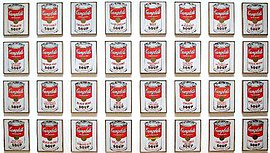
Anais Zhang’s NFTs: The Goddess of a Hundred Avatars
The Creation of an NFT Collection
NFT collections are relatively recent but already adhere to well-established rules. You begin by creating a dozen main characters (apes, kitties, zombie pandas, skateboard rabbits, etc.) on your computer. Then you imagine key elements (different backgrounds, accessories, facial expressions, attitudes, etc.). By combining all these elements with the characters, you obtain thousands of avatars. Even if some of them are very similar, each one is unique. So with a matrix of 12 characters, you can produce an amazing number of digital pictures that can be sold as original and unique creations. Our Heroji project follows similar guidelines. We have chosen 12 pagan gods, male and female, from different civilizations around the world. Each one represents a natural element: Egyptian Nut represents stars, Japanese Fujin represents the wind, Australian Yawkyawk represents fresh waters, etc. Artist Anais Zhang had to imagine the key elements. Some, like the moods (unwavering, blasé, wrathful, content, disillusioned, meditating, revengeful, surprised) or the complexions (cold, warm, vibrant, mellow), are common to all the gods or Herojis. Others, like the emblems (usually three) or the headdresses (four), are specific to each god. It must be noted that the artist imagines the images of the gods and the key elements. Even though it is digital, the painting is an expression of the artist’s talent and technique. The computer assists in creating the combinations to produce the required number of avatars. All these pictures have a family resemblance; you recognize at once a Heroji created by Anais Zhang. They form a series or collection, but each piece is unique. We shall examine this more closely with the example of goddess Nut.
The Originality of the Herojis
Most NFTs are cartoon drawings, meaning they are not realistic and often exaggerate body parts. Are cartoons a form of art? In some cases, yes, but most NFTs do not have artistic ambitions. The cryptokitties are cute but are not pieces of art, and we could find even cuter kitties on the internet. However, the possibility of breeding the kitties and creating new avatars is a fun concept. Anais Zhang discovered digital painting relatively recently. Before, she used traditional means (oil, acrylic, canvas, paper). Her work is influenced by Impressionism and Fauvism and is characterized by vibrant colors. Her digital paintings maintain these characteristics, but she has learned to make full use of the possibilities offered by digital painting (new colors, transparency effects, overlapping, repeated patterns). Nancy Spero resurrected mythological figures, but she did not change the shape or aspect of her models. Anais Zhang is also inspired by ancient art, but she reinvents the images of the gods. Pagan gods have become very popular in modern culture, but the style of the pictures we find in online art communities like Deviantart or video games like Lost Kingdoms or in the Forgotten Realms, the setting of the game Dungeons and Dragons, is influenced by illustrations from old children’s books, comic strips, manga, and anime. The images are often produced by artificial intelligence. This style suits the purpose of these pictures and the audience they aim to reach. Anais Zhang has other ambitions. She has mastered a new and fascinating tool and is exploring new themes, but there is a definite continuity between her previous art and the Heroji project.
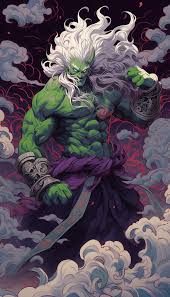
Nut and the Milky Way
The matrix: Anais Zhang studies ancient representations of the gods. In ancient Egyptian art, as we have seen, Nut is often represented as a female with a blue body, sprinkled with stars, arched over the earth. In this first phase of the project, Anais can only show the faces, so she cannot feature the arched body, which is so characteristic. However, the matrix image is dominated by intense blue and violet tones. The goddess has a blue face, her hair, straight and plaited like the elegant women in Egyptian art, is sprinkled with stars, and she is featured with the Eye of Ra. Her headdress is a blue pot with horns. The pot appears in ancient pictures of Nut, a wordplay on her name and probably a symbol of fertility. Nut was sometimes pictured as a cow, hence the horns. The blue face disappears in most avatars; the artist has to obey the variation rule, but the emblems and accessories remind us that Nut is an Egyptian sky goddess. Each Heroji usually has four different headdresses. Nut is featured with a vulture ornament. There are no ancient pictures of Nut with such a head jewel, but the vulture, as a bird of death and the underworld, is a part of her imagery. She is also adorned with a golden ankh, a cross associated with royalty and divinity, a symbol of life and death and hidden knowledge. But in pictures, Nut holds the amulet in her hand. The artist has cleverly changed it into a head ornament. There is also a sort of tiara made of a boat carrying the Sun. According to the myth, Nut swallowed the Sun each night, and it traveled through her body on a funerary boat, released in the morning. The emblems will also show how the artist freely uses ancient representations. We can also admire her creativity in the way she inserts the emblems in the medallions. Each god has three emblems. For Nut, we find exquisite boats: she protects the deceased on their journey to the underworld. There is also the sycamore, a sacred tree. She is also a tree spirit and she offers fruit and water to the recently deceased for their last journey. The last emblem is a Milky Way, a very astute way of reminding us of the ancient pictures of Nut as a woman arched over the earth. Here are a few pictures that will show how the key elements are selected and combined to create avatars. [Include links to images
The Heroji project has a great ambition: to develop activities to preserve our planet. The pagan gods are resurrected to be symbols and champions of ecology. We could argue that this ecological message is not obvious or explicit in the avatars. What a difference with the violent images of Nancy Spero, who often inserts texts and slogans in her work! In the next phases of the project, we shall see the Herojis engage in epic and cosmic battles, and they will live in the metaverse. However, one must consider that NFT collections create communities that share the same interests. And we can only hope that the Herojis will create a community dedicated to ecology. So there are the pictures and all the activities surrounding the pictures. Nut is the Milky Way, and the Milky Way could be a good symbol for the Heroji project: it is made of countless stars, the avatars, similar to each other but also unique, each one an essential part of a dazzling ensemble. But it is also made of constellations, the brave activists who will fight for a better and brighter world.
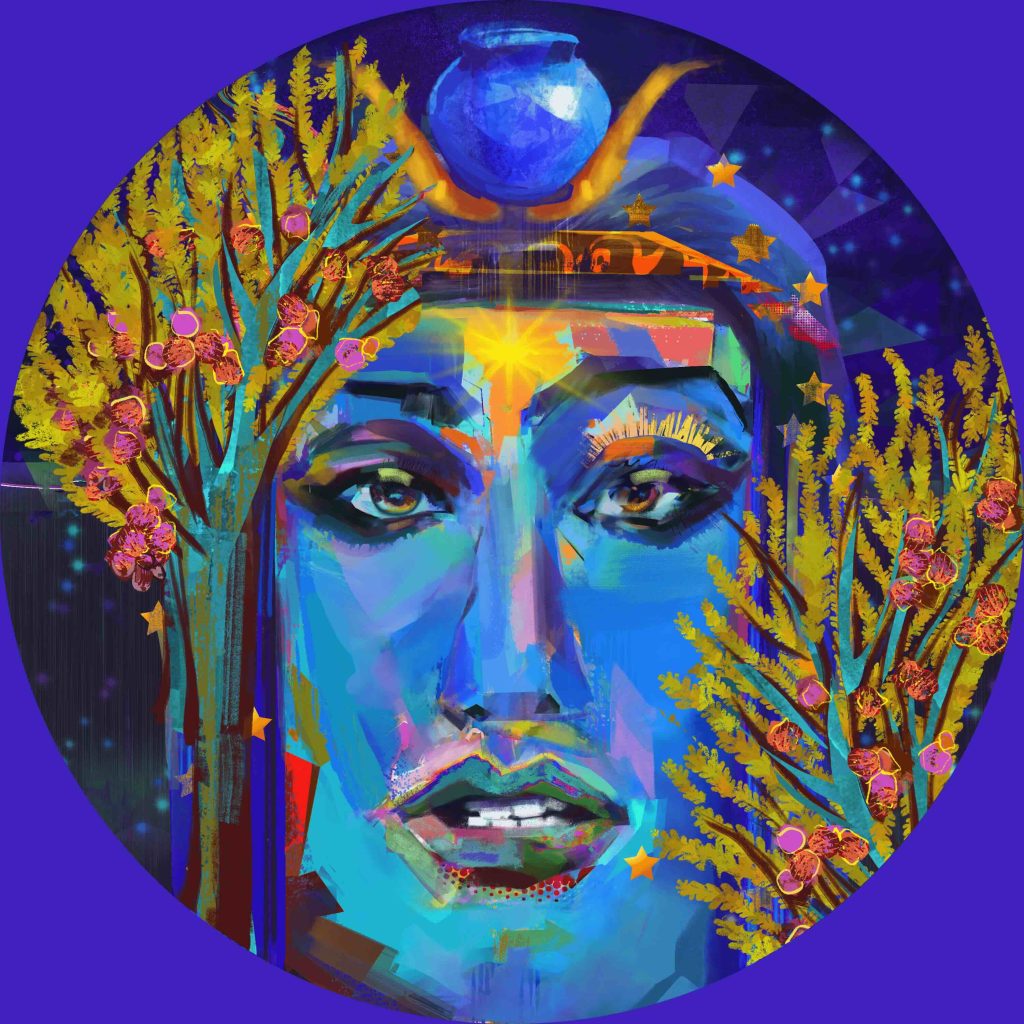
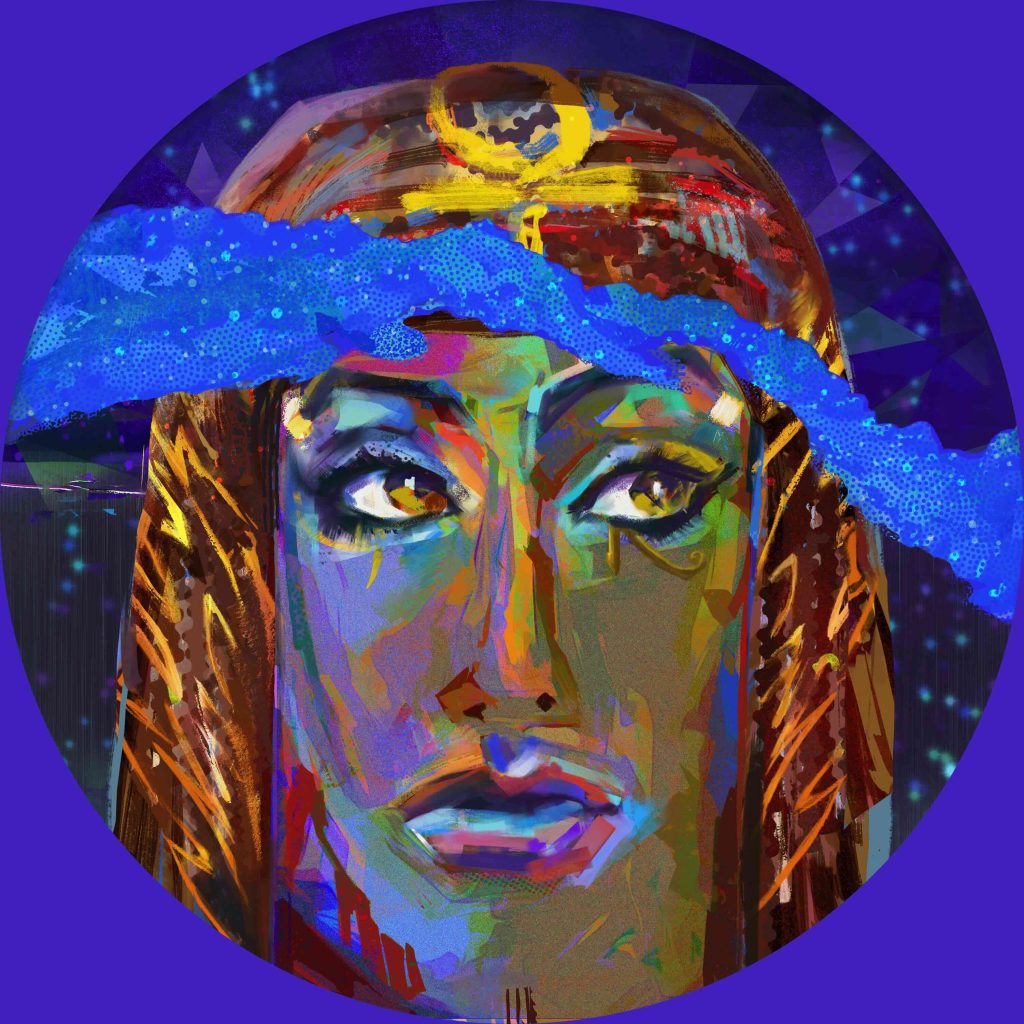
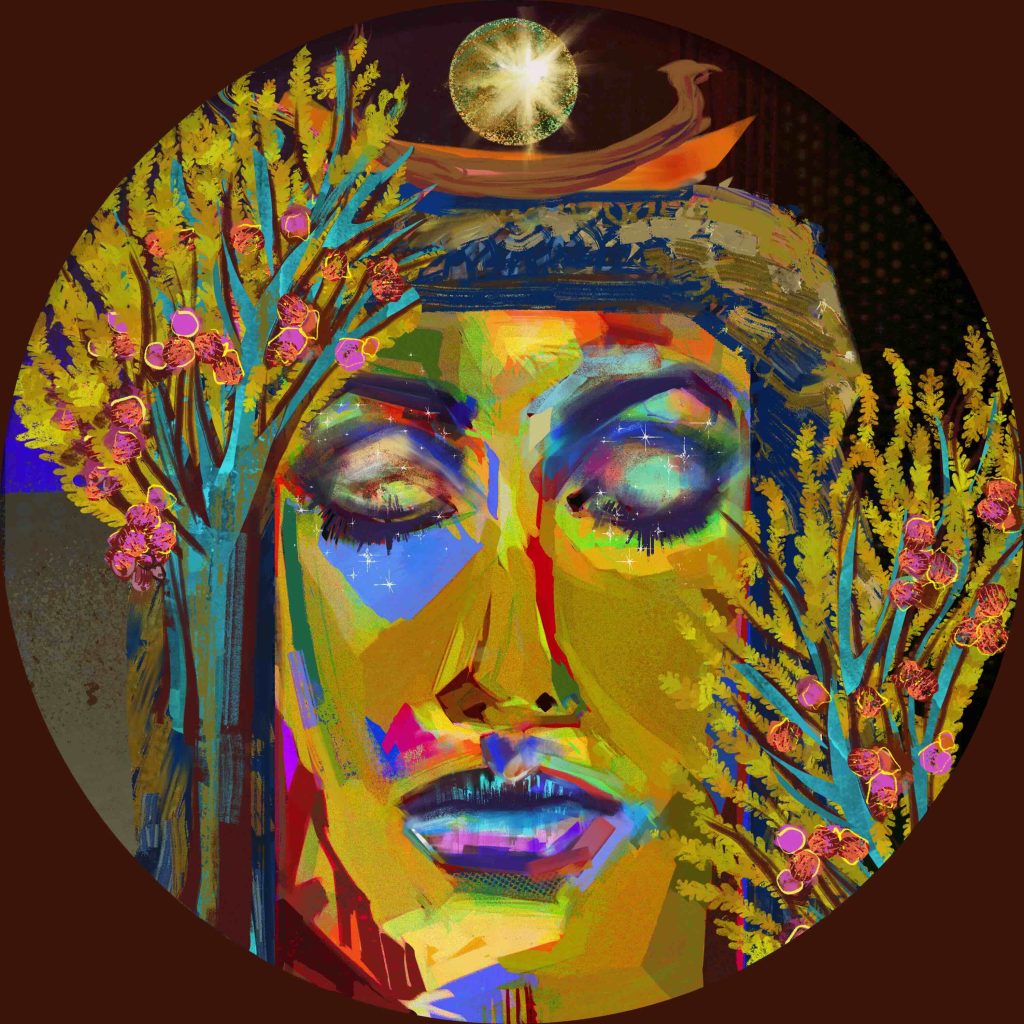
In its beginnings, digital art was mainly founded on repetitions and series. NFT collections seem to fulfill Andy Warhol’s dream of manufacturing thousands of artworks in one day. The avatars can be sold as unique and individualized creations. So are we only talking of profit, merchandise, and marketing? Series have always been part of art: Monet painted a haystack under different lights and at different times of the day, and more recently, Nancy Spero has shown the artistic and political use of serigraphy. We can only hope that the generous project of the Herojis will open the traditional art gallery to a galaxy, to the real universe, and the virtual metaverse.
References
https://www.galerielelong.com/
You can also discover more about Anais Zhang: https://anais.studio/
Images
Cloudfront.net; Melissaindenile.com; Wikimedia.org; Gstatic.com;
J. Verdun, March 2024.
